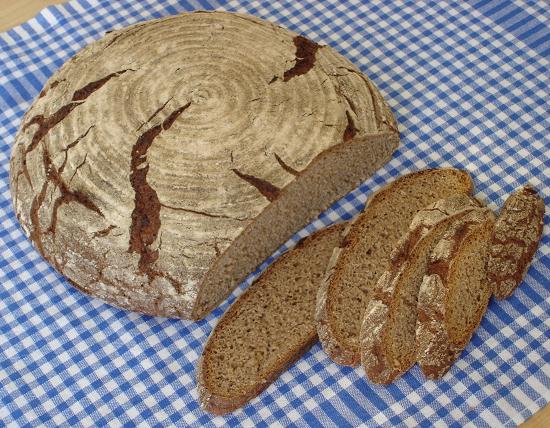Rye Bread
Ingredients: 1000 g whole grain rye flour, 16 g salt, water

Preparing the rye sourdough leaven
-
Begin at noon by mixing about 30 g of rye sourdough* with 50 g of flour and 55 g of lukewarm water. Place this mixture into a jar that keeps the temperature and humidity, and sprinkle flour on it. Cover the jar with a towel and leave it for 6 hours at 25° C (77° F). (As a result of the fermentation, the temperature inside the jar will be slightly higher.)
* If you do not yet have any sourdough, use the following procedure to make it yourself from microorganisms (lactobacilli and yeasts) found in the flour and in the air (the weather should not be hot): Mix 60 g of flour with 85 g of water and leave it covered with a towel for 1 or 2 days (stir it gently once or twice during that time) at 25° C (77° F), until bubbles appear at the surface and it smells a little sour. Refresh this starter sourdough a couple of times according to steps 1 to 3 to get a strong sourdough leaven, the first time using slightly higher temperatures.
-
Add 150 g of flour and 90 g of water and mix everything. Sprinkle flour on it and leave it covered for 14 hours at 20° C (68° F).
-
Add 300 g of flour and 320 g of lukewarm water. Mix it and sprinkle flour on it. Leave it covered for another 4 hours at 28° C (82° F). (The jar should be large enough for the dough to rise to twice its original volume.)
You now have a large amount of fresh rye sourdough*. Take 30 g of it and store it in the refrigerator for the next time.
* There are several methods of preparing rye sourdough. The three-stage progress described here (beginning with a humid stage to increase the yeasts and a cool stage to generate acetic acid) is based on the traditional German method of making sourdough.
Making the bread
-
Put 400 g of flour into a bowl, add the sourdough, 285 g of warm water and 16 g of salt. Knead strongly for 10 minutes. Then leave the dough covered for 30 minutes at 27° C (81° F).
-
Sprinkle a small amount of the remaining 95 g of flour on a baking pan, and pour the rest on a work surface. Put the soft, sticky dough on top of it, cover your hands with flour, and put the dough in the shape of a ball by pressing one side of it from the top to the inside and then rotating the dough a little, repeating this several times, until most of the flour is in the dough. Finally, cover the dough with the small amount of flour that remains, turn it (so the closure is at the bottom), and place it on the baking pan. Then allow it to rise for 1 hour at 27° C (81° F). (You can also let the bread rise in a special dough rising basket, which should be well dusted with flour. In this case the amount of water in step 4 can be increased by 15 g. Since you do not need the baking pan to let the bread rise, you can further improve the bread by baking it on a pizza stone, which you put in the oven during preheating. It is not necessary to sprinkle flour on the stone.)
-
Preheat the oven to 240° C (465° F). Then put the baking pan with the dough into the oven and bake it for a total of 90 minutes, for the first 20 minutes with a lot of steam. Reduce the heat to 160° C (320° F) after that time. (If your oven does not have a steam function, I recommend to place a flat thick metal bowl in the oven when preheating and to pour water into it when baking starts.)
-
Put the bread on a rack to cool until the next morning. The weight of the bread is about 1400 g. To eat, cut 1 cm slices and spread butter on them, for example. Only cut as many slices as you want to eat at a time. Keep the bread in a dry place (not in the refrigerator, and not sealed) with the edge you cut from down. The bread stays fresh for about a week. Enjoy the taste of rye!
Modify this recipy to match your taste. Here are some ideas:
Mixed flour bread: Replace some or all of the rye flour in steps 4 and 5 with the same amount of wheat flour (bread flour / strong flour / type 55 / type 550). For every 100 g of wheat flour reduce the amount of water (in step 4) by 10 g and the baking time (in step 6) by 5 minutes. You can cut slashes on the top just before baking to increase the amount of crust. If you use a high amount of wheat flour it may be necessary to use a lower baking temperature in the beginning or to turn it down earlier. The bread stays fresh for a couple of days.
Seasoning: In step 4 add a small amount of some of the following ingredients to the dough: coriander, caraway seeds, fennel, sesame seeds, flax seeds, sunflower seeds, pumpkin seeds. (Adjust the amount of flour and water if necessary). Or put caraway seeds, rolled oats, sunflower seeds, sesame seeds or poppy seeds on the top of the bread in step 5.